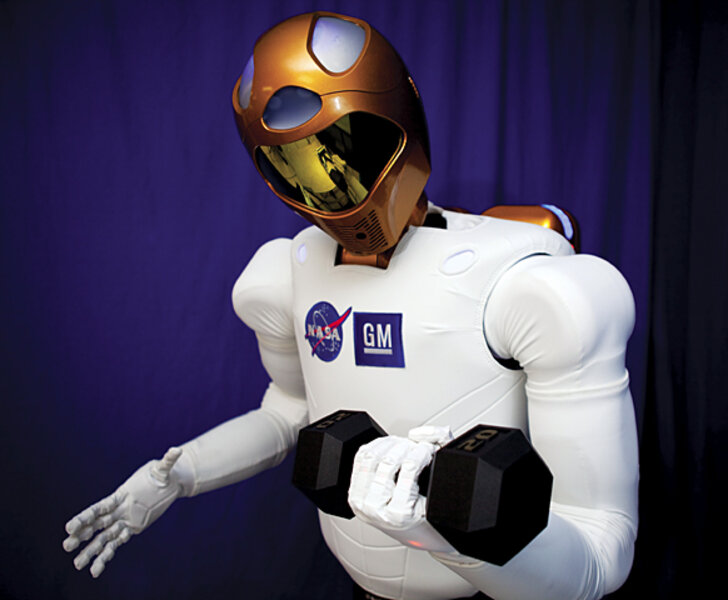'R2' humanoid robot to blast off with space shuttle launch
Loading...
Quick quiz: When the space shuttle Discovery makes its oft-delayed liftoff for the International Space Station (ISS), how many crew members will be aboard?
Six, you say? Make it 6-1/2.
Sporting a streamlined bronze helmet with an Iron Man-cool reflective visor, plus a white form-fitting uniform that would turn heads at the local gym, that extra half is R2. Think pencil-necked Power Ranger with no legs.
R2 is the waist-up portion of a humanoid robot – a prototype "robonaut" that could become just as at home on a factory assembly line as repairing power converters on the outside of the space station or holding a wrench while an astronaut fixes a cranky Colbert exercise machine.
Indeed, half of the replaceable components on the ISS can only be swapped out by humans in spacesuits, notes Ron Diftler, robonaut project manager at the Johnson Space Flight Center in Houston. Preparations for spacewalks are time-consuming, and outside the air lock the work is downright dangerous.
"Our goal with robonaut is to build a robot that approaches the dexterity of a spacesuited astronaut," Mr. Diftler says. "Once we do that, that robot has multiple roles."
In addition to taking over some of the more routine spacewalk duties, a robot could relieve astronauts of mundane tasks inside the station. A robot could even serve as a kind of plumber's apprentice.
Sometimes, one crew member is just floating around holding something for another, Diftler says. "Robots will do that and never get bored or ... complain."
Much has been said about the space station as a lab for developing new materials, new pharmaceuticals, and for learning more about how humans respond to living for long periods in microgravity. R2's arrival marks the start of using the station as a lab for experiments in human-robot teamwork that will be necessary in exploring space beyond low-Earth orbit.
"Having the robot up there working both inside ... and outside the vehicle side by side with crew will leave us far better prepared" when human-robot teams head to the moon or Mars, Diftler says.
The robonaut effort began in 1996 as a joint project between the National Aeronautics and Space Administration (NASA) and the Defense Advanced Research Projects Agency.
First out of the workshop and into the Arizona desert was Robonaut 1, aptly named Centaur. Robonaut 1's torso sat at the front of a four-wheeled rover – giving it the look of the mythical creature, but crowned with that futuristic helmet.
In September 2006, a team from four NASA centers put Centaur through its paces near Meteor Crater, Ariz. The goal was to see how well a spacesuited astronaut could work with several robots, from Centaur to more-familiar rovers.
The four-wheeled wonder had sufficient dexterity to pick up small rocks, transfer sample boxes from one vehicle to another, and even clip safety tethers to stanchions to secure another robot working on a slope.
Meanwhile, up in Detroit, General Motors had been following the program.
The automaker invited the robonaut program's chief, Robert Ambrose, to visit Detroit and give a seminar on the effort's progress. In 2007, NASA and GM inked a deal to work together on Robonaut 2.
"Surprisingly, there's a very large overlap between the capability requirements" each partner sought, says Marty Linn, a principal robotics engineer at GM and the automaker's point man on the project.
For instance, both want robots that can handle flexible objects in a humanlike way. For GM, those objects might be auto carpeting or weatherstripping. For NASA, it's soft goods like space blankets, which provide thermal protection for components on the station's exterior.
That demands subtle changes to the amount of force a robot's arms, hands, and fingers apply. It requires sophisticated sensors and electronics to monitor that force and feed the information back to motors and actuators controlling a hand's grip. And it requires hands with as wide a range of motions as the human hand exhibits.
These actions needed to take place at humanlike speeds and with humanlike sensing. Oh, yes, and all of the hardware, including the electronics controlling it, needs to be packaged in human-sized features. That, Mr. Linn says, presented one of the biggest challenges.
The end result, he says, "is one of the most advanced packages you'll ever be able to find."
It's also a dense package. R2 is only a torso with hands, arms, and head. But at 300 pounds, it weighs as much as a pro football nose tackle. With that kind of mass, fine motor skills and subtle control are a must if a robot is to work safely beside humans in microgravity or along an assembly line, Linn explains.
Initially, space-station astronauts will mount R2 on a stand that can be fixed to foot restraints on the space station's floors.
After the initial checkout, engineers have designed a set of tasks for R2 to perform that mimic those the crew faces inside and outside the station.
"Once the robot earns its stripes, we're thinking of handing over some of the mundane tasks the crew currently has to do, things like vacuuming air filters," NASA's Diftler says. Eventually, he envisions improvements to R2, including a single "leg," and giving it mobility – for instance, using handholds inside the station and outside to move in monkey-bar fashion to its next work location.
And if, perish the thought, R2 fails to live up to expectations, even with upgrades? NASA has no plans to bring it back, Diftler says.
Perhaps a cosmic "walk the plank" would be in order?





